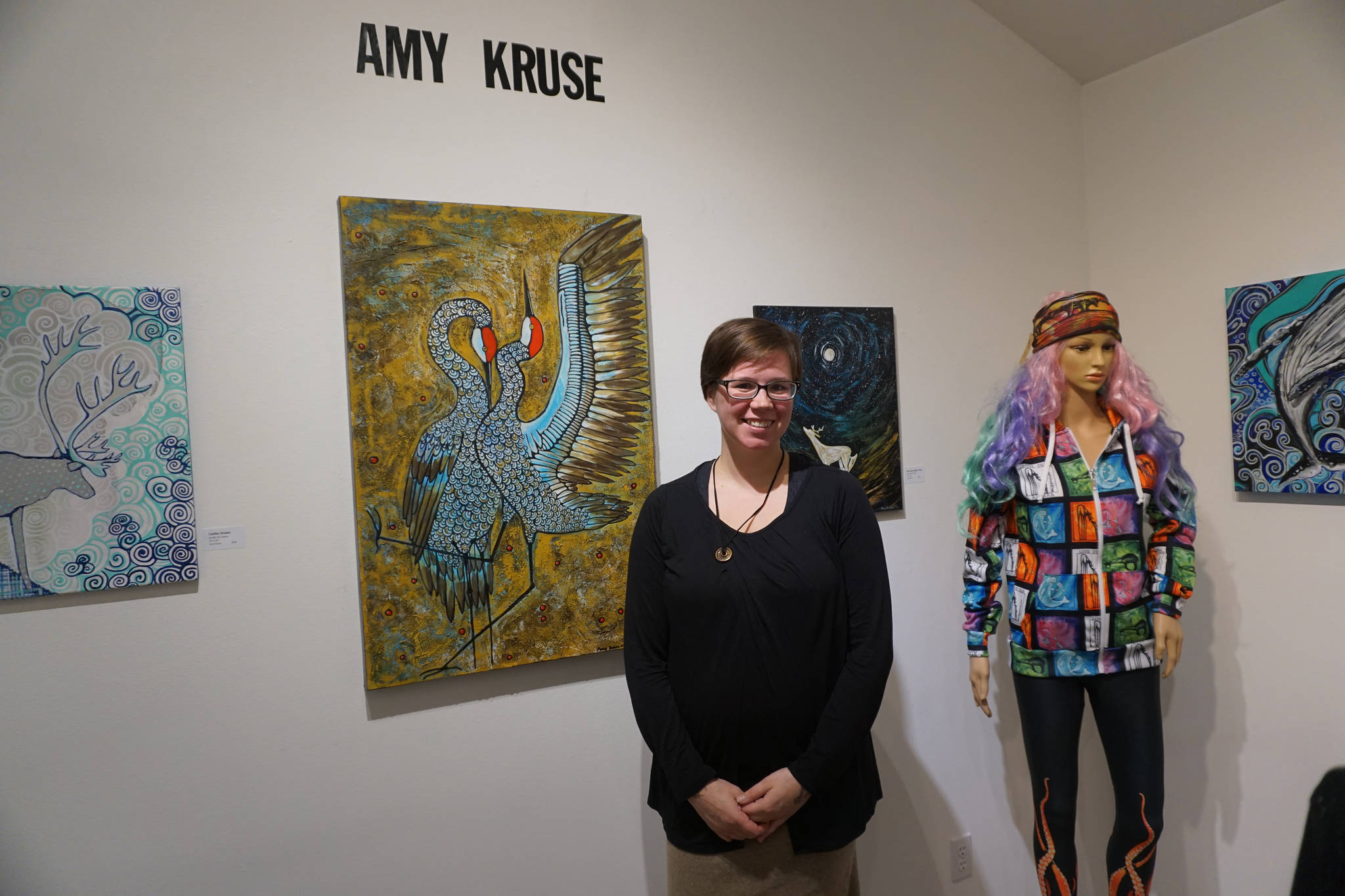Web commerce and new media technology has created challenges for brick-and-mortar stores and traditional publications, but it also has spawned new opportunities for visual artists. Artists like Salmon Sisters Emma Teal and Claire Laukitis, Felicity Rae Jones, Chelsea Horn and Oceana Wills market their art online through their own e-commerce sites or portals like Etsy. Horn and Wills sell prints while the Salmon Sisters and Jones transform their designs into screen printed clothing, vinyl stickers and even adult coloring books.
As seen at her first solo show this month at Fireweed Gallery, Amy Kruse joins that small stable of lower Kenai Peninsula artists with her Love From Alaska (lovefromalaska.com) line of clothing. Like M.C. Escher her paintings hold hidden within intricate patterns that through graphic design programs like Photoshop and Illustrator she turns into clothing motifs.
“The whole thing has changed. Just the arts has changed drastically with technology in the past 10, 20 years,” Kruse said Monday in a phone interview from her Ninilchik home. “There’s a lot of new, young artists like myself who are coming out on their own and utilizing more public spaces. It feels like it was the right thing for me to do.”
Kruse, 32, was born in Oregon, but moved to Ninilchik in third grade when her logger father came up to work during the timber boom of the 1980s and 1990s. She graduated from Ninilchik High School and went to the University of Alaska Anchorage to study art.
“Immediately I went to UAA and signed up for a ridiculous amount of art classes,” Kruse said. “Then I figured out school wasn’t for me.”
She moved back to Ninilchik. Kruse worked in a variety of jobs before she returned to her art.
“I started to do it more because I had to. It was this need in me I had to create,” she said.
Married 10 years and with a 4-year-old son, Kruse also started pursuing art as a money making career — the classic challenge of many a Homer artist, writer, poet and musician, but with the twist of being a parent.
“I wanted to stay at home with him, but also to see if I could make it during years I was at home with him,” she said of her son.
Other artists have designed images for screenprinted shirts and hoodies, but Kruse has found a new twist on textile art. Working with a fabric designer and printer in Los Angeles, and using computer graphics, Kruse adapts her images to fit pieces of clothing. For example, on a pair of leggings, there might be four panels: the legs, the waist, a pocket and ankles. The fabric printer gives her the templates like a clothing pattern.
“I would just indicate exactly where I want everything,” Kruse said.
That approach allows for designs to be put so as to best display the art. A coat might have a repeating series of images, while an octopus design on leggings shows tentacles curving down the legs. In effect, her art becomes more than an image on clothing, but fashion in itself.
Kruse’s printer uses a technology called dye ink sublimation printing. The image gets printed with heat-sensitive ink on paper that then is placed on fabric. The paper gets heated and pressed into the fabric, and the fabric absorbs the colors.
“It essentially dyes the fabric and becomes one with it. It won’t crack and wear and wash out,” Kruse said. “… It’s definitely a technology that’s becoming more prevalent and more affordable. It’s just on the cusp of taking over how most garments are manufactured, especially in this country.”
It might seem a contradiction, but Kruse said she finds the best images for her design come from paintings she’s done where she isn’t deliberately creating patterns. Over the past 10 years of serious painting she has amassed a huge collection of work.
“I’m finding when I paint something with an intention to making it into a pattern, it doesn’t seem to be quite as successful,” she said. “When I paint a piece wanting to be a pattern I overthink.”
Like other coastal Alaska artists, Kruse paints a lot of ocean and marine images. She has partnered with the Beluga Whale Alliance in Girdwood and created a design featuring beluga whales swimming in the sea.
“A lot of time when I paint I don’t even have a plan. It just turns into something with a lot of water. I see an image in the water. Within the image I see a pattern. It’s so much more successful and different,” she said.
Kruse also sells her work at brick-and-mortar stores in Ninilchik at the Ninilchik Peddler and in Soldotna at Mountain Mama’s Originals and Artzy Junkin. Her keychains are sold in Homer at the Bagel Shop. At this year’s Salmonfest, Kruse sold her designs at a booth she shared with the Ninilchik Peddler.
“I did phenomenal. People blew me away. It was so supportive,” she said. “It was so fun to see people wear the designs during the festival, too.”
Kruse got invited to do a show at Fireweed when gallery owner Irene Randolph saw her work at a craft and art show at Second Star. Kruse had never done a solo show before and was pleased with how it turned out.
To learn computer design, Kruse went online for YouTube videos. She took the same approach to marketing, but gets ideas and hints from other arts entrepreneurs like her.
“It’s a support group — asking questions. They get input from other people doing the same thing,” she said. “My support group is my demographic in the area.”
Breaking into art entrepreneurship might seem insurmountable, but it’s something many artists can do, Kruse said.
“I just keep thinking how literally anybody could do what I’m doing. You just have to do it. You can’t be afraid,” she said. “You have to figure out what you want and just do it.”
Reach Michael Armstrong at michael.armstrong@homernews.com.


